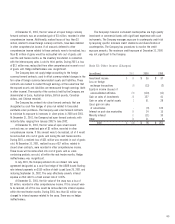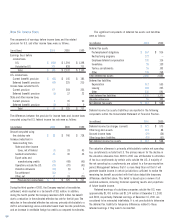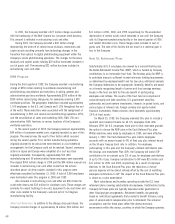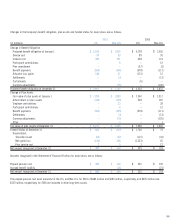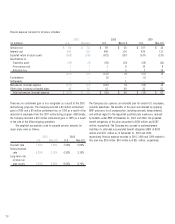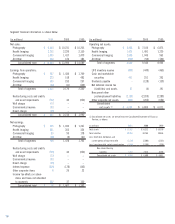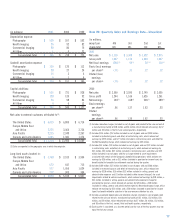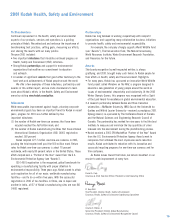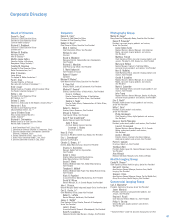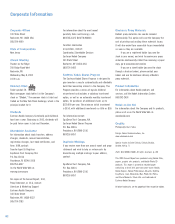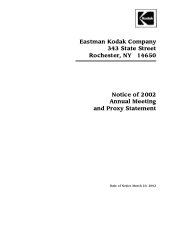Kodak 2001 Annual Report Download - page 77
Download and view the complete annual report
Please find page 77 of the 2001 Kodak annual report below. You can navigate through the pages in the report by either clicking on the pages listed below, or by using the keyword search tool below to find specific information within the annual report.
75
September 1997 for the purpose of developing and marketing new digital
color printing solutions for the graphic arts industry. In connection with
these arrangements, the Company serves as a supplier both to
Heidelberg and NexPress for consumables such as photoconductors and
raw materials for toner/developer manufacturing.
During 1999, the Company also completed additional acquisitions,
none of which are individually material to the Company’s financial
position, results of operations or cash flows, which had an aggregate
purchase price of approximately $3 million in cash.
Note 20: Sales of Assets and Divestitures
1999 In April 1999, the Company sold its digital printer, copier-
duplicator, and roller assembly operations primarily associated with its
Office Imaging operations, which included its operations in Rochester, NY,
Muehlhausen, Germany and Tijuana, Mexico to Heidelberg for
approximately $80 million. The transaction did not have a material effect
on the Company’s results of operations or financial position.
In November 1999, the Company sold The Image Bank, a wholly-
owned subsidiary which markets and licenses image reproduction
rights, to Getty Images, Inc. for $183 million in cash. As a result of
this transaction, the Company recorded a gain of $95 million in other
income (charges).
In November 1999, the Company sold its Motion Analysis Systems
Division, which manufactures digital cameras and digital video cameras
for the automotive and industrial markets, to Roper Industries, Inc.
for approximately $50 million in cash. As a result of this transaction,
the Company recorded a gain of $25 million in other income (charges).
Note 21: Segment Information
Beginning in the fourth quarter of 2001, the Company changed its
operating structure, which was previously comprised of seven business
units, to be centered around strategic product groups. The strategic
product groups from existing businesses and geographies have been
integrated into segments that share common technology, manufacturing
and product platforms and customer sets. In accordance with the change
in the operating structure, certain of the Company’s product groups were
realigned to reflect how senior management now reviews the business,
makes investing and resource allocation decisions and assesses operating
performance. The realignment of certain of the Company’s strategic
product groups resulted in changes to the composition of the reportable
segments.
As a result of the change in composition of the reportable segments,
the accompanying 1999 and 2000 segment information has been
presented in accordance with the new structure and to conform to the
2001 presentation. The Company has three reportable segments:
Photography; Health Imaging; and Commercial Imaging.
The Photography segment derives revenues from consumer film
products, sales of origination and print film to the entertainment
industry, sales of professional film products, traditional and inkjet photo
paper, chemicals, traditional and digital cameras, photoprocessing
equipment and services, and digitization services, including online
services. The Health Imaging segment derives revenues from the sale of
digital products, including laser imagers, media, computed and direct
radiography equipment and picture archiving and communications
systems, as well as traditional medical products, including analog film,
equipment, chemistry, services and specialty products for the
mammography, oncology and dental fields. The Commercial Imaging
segment derives revenues from microfilm equipment and media, printers,
scanners, other business equipment, media sold to commercial and
government customers, and from graphics film products sold to the
Kodak Polychrome Graphics joint venture. The All Other group derives
revenues from the sale of organic light emitting diode (OLED) displays,
imaging sensor solutions and optical products to other manufacturers.
Transactions between segments, which are immaterial, are made on
a basis intended to reflect the market value of the products, recognizing
prevailing market prices and distributor discounts. Differences between
the reportable segments’ operating results and net assets, and the
Company’s consolidated financial statements relate primarily to items
held at the corporate level, and to other items excluded from segment
operating measurements.


